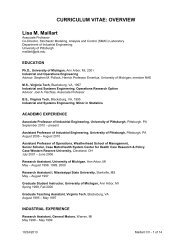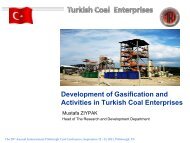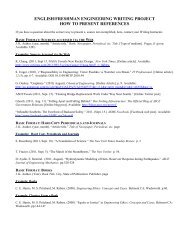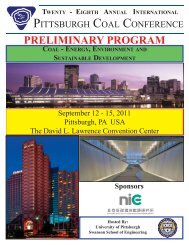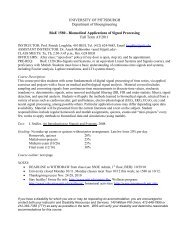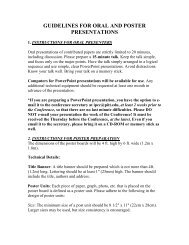Abstract Booklet 2006 - Swanson School of Engineering - University ...
Abstract Booklet 2006 - Swanson School of Engineering - University ...
Abstract Booklet 2006 - Swanson School of Engineering - University ...
Create successful ePaper yourself
Turn your PDF publications into a flip-book with our unique Google optimized e-Paper software.
is only slightly affected with increased paraffin formation, which is believed to be due<br />
to a slight shift <strong>of</strong> primary product selectivity as well as effects <strong>of</strong> secondary<br />
hydrogenation. It is further shown that these effects are not due to uneven potassium<br />
promotion and that the iron and copper need to be co-precipitated in order to achieve<br />
maximum oxygenate promotion.<br />
P6-4<br />
A Gaming Framework for Analyzing Market Potentials and Risks <strong>of</strong> CTL<br />
A. Tuzuner, Zuwel Yu, Purdue <strong>University</strong>, USA<br />
Coal-to-liquids (CTL) has been attracting a lot <strong>of</strong> attention due to persisting high crude<br />
oil prices, energy security concerns, large reserves <strong>of</strong> coal in many oil importing<br />
countries etc. Both the direct coal liquefaction (DCL) and indirect coal liquefaction<br />
(ICL) processes are proven technologies. However, whether the CTL business will<br />
survive in an open global market depends on many factors, which can be mapped to<br />
risks. The most determining factor <strong>of</strong> the viability <strong>of</strong> the CTL business is future oil<br />
price movement. According to many studies, oil prices will have to be above $35-<br />
40/bbl for the CTL business to survive, depending on the location and coal use <strong>of</strong> the<br />
CTL business. An immediate question is: Do oil exporting countries have the incentive<br />
to reduce oil prices The answer is: If there is no threat <strong>of</strong> entry to snatch the market<br />
shares <strong>of</strong> these oil exporting countries, they may not have the incentive to reduce oil<br />
prices by increasing their production. Hence, CTL can be regarded as a threat <strong>of</strong> entry<br />
into oil market to force the oil exporting countries to reduce prices through production<br />
expansion. Therefore, building the CTL capacity can be used as a gaming approach to<br />
reducing crude oil prices, which may benefit the oil importing countries in many<br />
aspects, including reduced oil prices, increased energy security, plus many other<br />
benefits such as job creation, balancing trade, cash flows improvement etc.<br />
The paper proposes a gaming model to find the equilibrium solution to the CTL<br />
capacity building. A stochastic mean-reversion price model is used, and the Nashequilibrium<br />
can be found using a stochastic root finding approach. In the equilibrium,<br />
the “best” CTL capacity will be calculated based on the “long-run” marginal cost <strong>of</strong><br />
the total CTL capacity in the world.<br />
P6-5<br />
Novel Magnetic Method for Separation <strong>of</strong> Iron Catalysts<br />
from Fischer-Tropsch Wax<br />
R.R. Oder, EXPORTech Company, USA<br />
We describe a novel continuous magnetic method for separation <strong>of</strong> nano-meter size<br />
iron catalysts from Fischer-Tropsch wax (patent pending). The method has been scaled<br />
up from the bench scale to prepare clean wax containing 0.1 to 0.5 wt.% catalyst from<br />
slurries containing 20- 25 wt.% catalyst at the rate <strong>of</strong> 50 barrels per day (BPD) feed<br />
wax at 500oF.1 We will discuss the operating mechanism <strong>of</strong> the separator which is<br />
housed between the poles <strong>of</strong> an electromagnet producing magnetic fields in the range<br />
<strong>of</strong> 0.2 to 0.5 Tesla throughout the working volume. The method achieves high levels <strong>of</strong><br />
catalyst separation from the wax by promoting magnetic agglomeration throughout the<br />
volume <strong>of</strong> the vertically oriented elongate cylindrical separation vessel. Downwardlydirected<br />
high velocity jet flows located adjacent to the inside walls <strong>of</strong> the separation<br />
vessel nearest the magnet poles are used to sweep the catalyst agglomerates from the<br />
magnetized volume <strong>of</strong> the separator. The jets are controlled to promote movement <strong>of</strong><br />
the agglomerates without causing turbulent mixing. Clean wax with a low<br />
concentration <strong>of</strong> catalyst is continuously issued from the top <strong>of</strong> the separator while wax<br />
slurry with a high concentration <strong>of</strong> catalyst is issued from the bottom <strong>of</strong> the vessel. Use<br />
<strong>of</strong> a supplemental separation method such as batch operated high gradient magnetic<br />
separation to treat the product <strong>of</strong> the first stage continuous magnetic separator has<br />
produced clean wax containing 0.01 wt.% catalyst.<br />
POSTER SESSION 7<br />
COAL CHEMISTRY, GEOSCIENCES AND RESOURCES<br />
P7-1<br />
Cleaning Potentality <strong>of</strong> natural Coke (jhama) through washability<br />
Investigation and Its Suitability for Different End Uses<br />
Ashok K. Singh, N.K. Shukla, Amrita Mukherjee, Mamta Sharma, N. Choudhury, T.<br />
Gauricharan, D.D. Haldar, Central Fuel Research Institute, INDIA<br />
Substantial reserves <strong>of</strong> natural coke (jhama) are available in Indian coalfields, but due<br />
to its peculiar physical and chemical properties, its suitability for different end uses has<br />
not been established. Earlier workers have attempted to find out new avenues for<br />
utilization <strong>of</strong> this material by producing coke from different blends <strong>of</strong> jhama with<br />
coking coal fines, obtained from coal washeries. In the present study, authors have<br />
attempted to study the washability characteristics <strong>of</strong> a typical natural coke from seam<br />
XIV A <strong>of</strong> Jharia coalfield. Results <strong>of</strong> conventional float and sink tests have been used<br />
to determine the yield <strong>of</strong> cleans at 10% and 15% ash content. The washability data<br />
reveals that a theoretical yield <strong>of</strong> ~20% and >80% is achievable at 10% and 15% ash<br />
levels. Different gravity fractions were further characterized (chemically and<br />
microscopically) to find out their suitability for carbon artefact industries. These<br />
studies on some <strong>of</strong> the gravity fractions having medium to high volatile matter and less<br />
to moderate ash content lead to the conclusion that the natural coke may be used for<br />
blending with power coal. Lower VM fractions may be recommended for cement<br />
industry.<br />
P7-2<br />
X-Ray diffraction analysis on the macerals <strong>of</strong> coals with different type-reductivity<br />
Haizhou Chang, Chuange Wang, Jun Li, Wenying Li, Kechang Xie, Fangui Zeng,<br />
Taiyuan <strong>University</strong> <strong>of</strong> Technology, CHINA<br />
In this article, X-ray diffraction (XRD) was carried out to study the crystallite<br />
characteristics <strong>of</strong> the vitrinite and inertinite from Pingshuo and Shendong coals with<br />
similar coal rank and petrographical composition but with different reductivity<br />
revealing the influence <strong>of</strong> the reductivity on macerals crystallite. Pingshuo (PR) coal<br />
was with stronger reductivity. Compared with vitrinite (PV) there was bigger<br />
crystallite size, higher regularity and aromaticity (ƒ a ) in inertinite (PI). Shendong (SR)<br />
coal was with weaker reductivity, its inertinite’s crystallite size and regularity were<br />
more obvious than vitrinite (SV), but almost same ƒ a value. The crystallite parameters<br />
<strong>of</strong> PV and SV are alike, which shows a good relationship with the petrographical<br />
likeness <strong>of</strong> PV and SV. Compared with PI, there is fewer aromatic layers and lower ƒ a<br />
in Shendong inertinite (SI). The content <strong>of</strong> highly disordered material called<br />
amorphous carbon was investigated. Results showed that PV was obviously higher<br />
than PI, SV is slightly higher than SI and PV, SI is obviously higher than PI. The<br />
characteristic that there were relatively lower ƒ a as well as more amorphous carbon in<br />
SI with weaker reductivity indicated that SI contains more active components, which<br />
might be related to the fact that SI contained plentiful semifusinite.<br />
P7-3<br />
Comparison <strong>of</strong> Microwave-Assisted Extraction and Soxhlet extraction<br />
Chen Hong, Lu Junqing, Ge Lingmei, Li Jianwei, Zhou Anning, Xi'an <strong>University</strong> <strong>of</strong><br />
Science and Technology, CHINA<br />
In order to compare extraction yields and the extracts, extraction with several single<br />
organic solvents under microwave-assisted and Soxhlet extraction were conducted for<br />
5 typical Chinese coals –Shenfu, Tongchuan, Huating, Yitai, Panzhihua coal. Above<br />
50% extraction yield was acquired for ethylenediamine under microwave-assisted<br />
extraction, conversely only 40% extraction yield were the highest for Soxhlet<br />
extraction. Extracts were analyzed by GC/MS. Influence <strong>of</strong> temperature, solvent, coal<br />
type on microwave-assisted extraction are also studied. The cause <strong>of</strong> different<br />
extraction yield on different coals was discussed.<br />
P7-4<br />
R&D <strong>of</strong> a New Technology <strong>of</strong> Conversion <strong>of</strong> Coke Oven Gas<br />
from Bituminous Coal into Syngas<br />
Yongfa Zhang, Kechang Xie, Taiyuan <strong>University</strong> <strong>of</strong> Technology, CHINA<br />
Ping Wan, Changchun Technology College, CHINA<br />
Guangliang Liu, Xia<strong>of</strong>ei Chen, Yan Liang, Jia Zhang, Li Yang, Shanxi Sunrise Coal<br />
Technology Ltd., CHINA<br />
A kind <strong>of</strong> new technology with an integrated apparatus (IA) for producing syngas from<br />
bituminous coal is developed. In the integrated apparatus three processes: coal<br />
pyrolysis, partial coal gasification and conversion <strong>of</strong> coke oven gas (COG) into syngas<br />
are completed and three products: syngas, ferro-alloy coke (semi-coke) and tar are<br />
produced in an environmental friendly manner. In this paper, the status <strong>of</strong> China’s<br />
semi-coke industry and coke oven gas utilization are introduced; the principle <strong>of</strong><br />
conversing CH 4 -rich gas such as COG into syngas with the assistance <strong>of</strong> H 2 O-O 2 in a<br />
high temperature carbon catalytic system are analyzed; and other technological issues,<br />
such as the process, main technical specifications <strong>of</strong> the integrated apparatus, product<br />
quality, energy consumption, financial estimation, and environmental protection etc.<br />
are discussed. It has been shown by research that the main technical specifications <strong>of</strong><br />
the integrated apparatus are as following: coal processing capability 23 T/d, coke yield<br />
14.7 T/d, tar yield 1.15 T/d, syngas yield 11960 Nm 3 /d. The syngas quality shows CH 4<br />
content 86.5%. The semi-coke is favored product used<br />
for Si-Fe alloy and carbide production. Its volatile rate is lower than 4.00% and<br />
electrical resistance is higher than 1506Ω.mm 2 .m -1 at 1300°C. The content <strong>of</strong> phenol in<br />
the tar is 16.25%. The integrated apparatus, a clean technology is energy and resource<br />
efficient.<br />
P7-5<br />
Niobium and tantalum content at Kuzbass coals<br />
Boris F. Nifantov, Vadim P. Potapov, Anatoliy N. Zaostorvskiy, Olga P. Zanina, The<br />
Institute <strong>of</strong> the Coal and Coal Chemistry SB RAS, RUSSIA<br />
At all deposits <strong>of</strong> the world coals contain niobium and tantalum which maintenance as<br />
a rule do not exceed clark levels. Last years the data <strong>of</strong> high contents <strong>of</strong> these metals at<br />
various coal-mining regions were published. In the present message are considered<br />
metal logenic and the geochemical data <strong>of</strong> niobium and tantalum contents<br />
accompanied by Sc, Ti, Fe, Y, Zn, Ce, Hf, Th, U at III - XVII layers <strong>of</strong> Tom-Usa<br />
Kuzbass region.<br />
54



